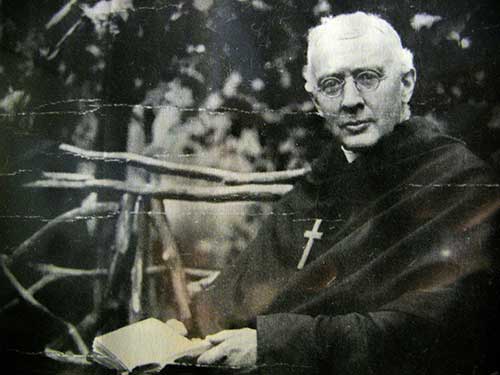
James’ (1854–1935) father was the first Episcopal Church Bishop of Central New York. He ordained James a priest on 30 May 1880. Feeling called to the monastic life, and rather than joining the Society of St. John the Evangelist in USA, with two companions, Fr James founded the Order of the Holy Cross. The life being too difficult, his two companions left, but James still made his profession as a monk. He is commemorated on the anniversary of this profession, 25 November 1884.
Holy Cross monastery was designed by Gothic-Revival Architect Henry Vaughan. It was the first building built for an Anglican religious order since the reign of Henry VIII.
In 1977, the Camaldolese and the Episcopalian Order of the Holy Cross agreed to work together. In 1979, the Camaldolese at Big Sur established a daughter house in partnership with the Order of the Holy Cross, living together in Incarnation Priory in Berkeley. They did not merge structures or liturgies but shared in each other’s life and worship as much as possible.
That ecumenical life together did not continue. But one of the effects of this relationship between the two orders was that it helped the Order of the Holy Cross realise that its ethos and practices were basically Benedictine. This lead the Order of the Holy Cross to adopt the Rule of Benedict in 1984.
From its nineteenth-century foundations, the Order of the Holy Cross had two affiliated groups, sharing its life, work, and vision. One group was for lay people, the other for clergy. Since the 1970s, these combined and became the Holy Cross Associates. Associates translate the order’s spirituality into their own context outside the monasteries. More than a thousand people are Associates of the Order of the Holy Cross.
O loving God,
by your grace your servant James Huntington gathered a community
dedicated to love and discipline and devotion to the holy Cross of our Saviour Jesus Christ:
Send your blessing upon all who proclaim Christ crucified
and move the hearts of many to look upon him and be saved;
who with you and the Holy Spirit lives and reigns,
one God, for ever and ever. Amen.
In the Rule for the Order of the Holy Cross, James Huntington wrote: “Holiness is the brightness of divine love, and love is never idle; it must accomplish great things.” Commitment to active ministry rooted in the spiritual life was the guiding principle for the founder of the first permanent Episcopal monastic community for men in the United States.
James Otis Sargent Huntington was born in Boston in 1854. After graduation from Harvard, he studied theology at St. Andrew’s Divinity School in Syracuse, New York, and was ordained deacon and priest by his father, the first Bishop of Central New York. In 1880 and 1881, he ministered in a working-class congregation at Calvary Mission, Syracuse.
While attending a retreat at St. Clement’s Church, Philadelphia, Huntington received a call to the religious life. He considered joining the Society of St. John the Evangelist, which had by that time established a province in the United States, but he resolved to found an indigenous American community.
Huntington and two other priests began their common life at Holy Cross Mission on New York’s Lower East Side, ministering with the Sisters of St. John Baptist among poor immigrants. The taxing daily regimen of Eucharist, prayer, and long hours of pastoral work soon forced one priest to leave for reason of health. The other dropped out for lack of a vocation. Huntington went on alone; and on November 25, 1884, his life vow was received by Bishop Potter of New York.
As Huntington continued his work among the immigrants, with emphasis on helping young people, he became increasingly committed to the social witness of the Church. His early involvements in the single-tax movement and the labor union movement were instrumental in the eventual commitment of The Episcopal Church to social ministries. November 25 566
The Order attracted vocations, and, as it grew in the ensuing years, the community moved, first to Maryland, and, in 1902, to West Park, New York, where it established the monastery which is its mother house. Huntington served as Superior on several occasions, continuing his energetic round of preaching, teaching, and spiritual counsel until his death on June 28, 1935.
Great Cloud of Witnesses
Holy Cross Monastery website
Holy Cross Monastery facebook page


